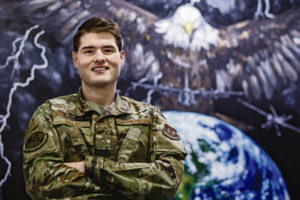
Communication is key to mission success. In the midst of a global pandemic where resources and manpower are limited, the 1st Air and Space Communications Operations Squadron utilizes virtual training to ensure their mission continues.
Commanders rely heavily on the ability to quickly and efficiently communicate up and down the chain, especially when it comes to moving important assets all over the globe. The 1st ACOS is responsible for managing those systems ensuring commanders have that capability.
The 1st ACOS mission is vast as their systems provide a wide array of functions and serve many purposes. They are a relatively small unit with a large scope that directly impacts and enables U.S. Air Forces in Europe – Air Forces Africa, Global Strike and U.S. Air Forces Central Command theater of operations.
“There’s one that deals with mission planning and logistics, which is our GCCS-AF, or Global Command and Control System-Air Force, and then GCCS-Joint handles more of the theater ballistic missile warning systems,” said 1st Lt. Jennings Fairchild, 1st ACOS theater network operations center officer in charge. “Another one probably takes up a majority of both our funds and manpower, which is our AF JWICS, or Air Force Joint Worldwide Intelligence Communications System.”
The AF JWICS allows for efficient multi-media communications between authorized individuals by secure means. Whether the 1st ACOS is working with JWICS or GCCS, the Airmen will remotely troubleshoot issues on these systems from their squadron, as well as provide onsite maintenance when necessary.
Because of coronavirus disease 2019, Airmen had to adapt to a new work environment. The 1st ACOS came up with a solution to ensure Airmen — both new and seasoned — received formal training.

“We’re still enabling training creatively to continue operations,” said Master Sgt. Shimir Bishop, 1st ACOS GCCS section chief. “Right now, we have 24 active slots for Airmen to receive virtual training to follow the physical distancing guidance during COVID-19.”
The training is a vital component to mission success as it gives the Airmen the knowledge on managing the systems in place.
“The training is extremely vital because of the programs we provide,” Bishop said. “Critical programs such as Agile Client, which allows the USAFE-AFAFRICA Nuclear Operations Center (U-A NOC) and all Command Post in USAFE to have situational awareness in the European theater. This program is a key part of the Common Operational Picture (COP) within all of our sites to track all movement: personnel, air, sea, and land assets. If they don’t have access to this client, they can’t support the mission.”
By having virtual training, Airmen can stay sharp and equipped with the knowledge to maintain and release new software when needed. They can even take the training in the comfort of their own homes, maintaining physical distancing during the COVID-19 crisis.
“We’re ensuring they have the skillset to operate and maintain the programs to keep operations in European Command, Africa Command and Central Command moving forward,” Bishop said.
Deployments are another aspect of the Air Force mission the 1st ACOS impacts daily. The Individual Deployment Readiness Center (IDRC) uses two different systems which rely on GCCS to move assets downrange effectively.
“There’s no efficient personnel movement without GCCS,” Bishop said. “The Joint Operation Planning and Execution Systems, or JOPES, and the Deliberate Crisis Action Planning and Execution Segments, DCAPES, are provided by the GCCS systems we consistently monitor. We push out critical updates through our servers to ensure these systems are always updated and that allows them to manage personnel and cargo movements.”
Without 1st ACOS Airmen trained and ready to provide their services, many units around the three combatant commands’ area of responsibility would have to rely on inefficient ways to do their jobs. Without JOPES and DCAPES access, the IDRC would have to process all deployers by paper, which could tremendously slow down the process.
Despite the physical distancing efforts, 1st ACOS Airmen have kept a positive attitude and are eager to get at the mission.
“Since I’ve been in the 1st ACOS, it’s been nothing but an incredible amount of hard work and dedication displayed to support a lot of different customers,” Fairchild said. “Especially during the COVID-19 crisis, there’s been an unwavering dedication to make sure our systems are up and running, and if there is a problem for whatever reason, whether during the duty day or after hours, Airmen are immediately ready to jump on that problem and make sure it gets taken care of.”


